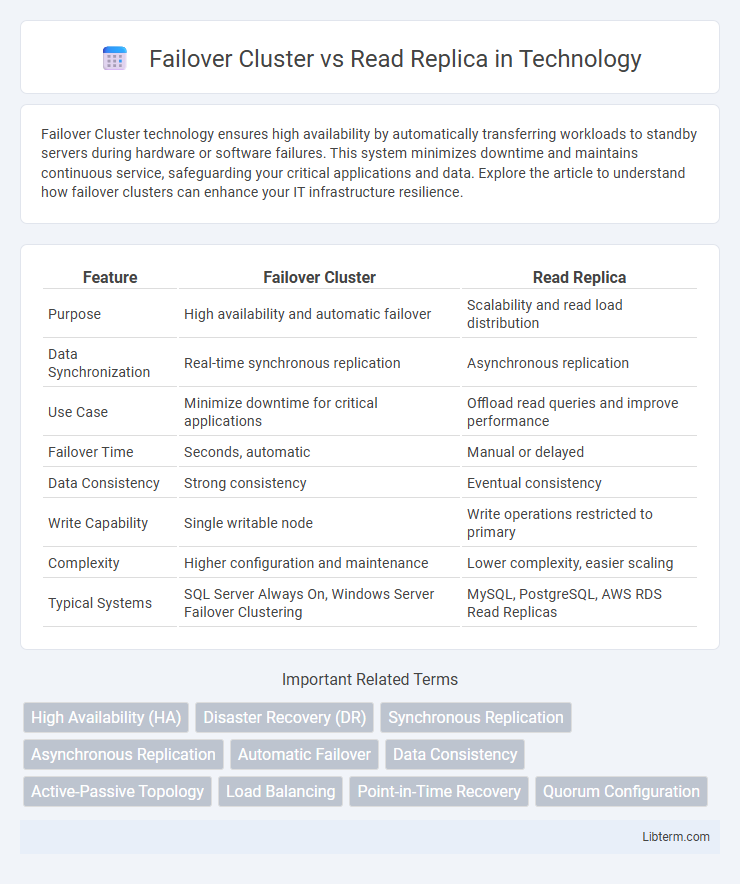Failover Cluster technology ensures high availability by automatically transferring workloads to standby servers during hardware or software failures. This system minimizes downtime and maintains continuous service, safeguarding your critical applications and data. Explore the article to understand how failover clusters can enhance your IT infrastructure resilience.
Table of Comparison
| Feature | Failover Cluster | Read Replica |
|---|---|---|
| Purpose | High availability and automatic failover | Scalability and read load distribution |
| Data Synchronization | Real-time synchronous replication | Asynchronous replication |
| Use Case | Minimize downtime for critical applications | Offload read queries and improve performance |
| Failover Time | Seconds, automatic | Manual or delayed |
| Data Consistency | Strong consistency | Eventual consistency |
| Write Capability | Single writable node | Write operations restricted to primary |
| Complexity | Higher configuration and maintenance | Lower complexity, easier scaling |
| Typical Systems | SQL Server Always On, Windows Server Failover Clustering | MySQL, PostgreSQL, AWS RDS Read Replicas |
Introduction to Failover Cluster and Read Replica
Failover clusters provide high availability by automatically switching to a standby server in case the primary server fails, ensuring minimal downtime and continuous service. Read replicas enhance read scalability by creating copies of the primary database that handle read-only queries, reducing the load on the main server. Both techniques improve database performance and reliability but serve different purposes: failover clusters prioritize fault tolerance, while read replicas focus on load distribution.
Core Concepts: Understanding High Availability and Replication
Failover Cluster provides high availability by enabling automatic server failover within a group of nodes, ensuring continuous service during hardware or software failures. Read Replica focuses on replication by maintaining synchronized copies of the primary database, allowing read operations to be distributed and reducing load on the primary node. Both technologies improve system reliability but differ in their approach: Failover Clusters prioritize uptime with seamless failover, while Read Replicas enhance read scalability and data redundancy.
Failover Cluster: Definition and Key Features
Failover Cluster is a high-availability solution designed to ensure continuous database operation by automatically transferring workloads to a standby server during hardware or software failures. It features shared storage, cluster nodes, and heartbeat signals to monitor node health and provide rapid failover, minimizing downtime. Key components include quorum configuration for cluster consistency and synchronous data replication, which guarantees data integrity across nodes in real-time.
Read Replica: Definition and Core Benefits
A Read Replica is a copy of the primary database that handles read-only queries, improving application performance and scalability by offloading read traffic. It ensures data consistency through asynchronous replication, providing a reliable solution for distributing read workloads without impacting the primary database's write operations. This architecture supports high availability and disaster recovery by enabling quick failover and load balancing across multiple replica instances.
Architecture Differences Between Failover Cluster and Read Replica
Failover Cluster architecture relies on multiple nodes connected through shared storage, where only one node is active at a time, ensuring high availability by automatic failover to a standby node. Read Replica architecture involves one primary database instance handling write operations and multiple replicas asynchronously replicating data to support read-heavy workloads and improve scalability. Failover Clusters prioritize data consistency and automatic recovery, while Read Replicas focus on load distribution and read performance optimization.
Use Cases: When to Choose Failover Cluster
Failover clusters are ideal for applications requiring high availability and automatic recovery during hardware or software failures, such as mission-critical databases and enterprise systems. They provide seamless failover by maintaining shared storage and synchronized nodes, minimizing downtime in transactional workloads. Choose failover clusters when data consistency and continuous uptime are paramount, especially in environments where write operations dominate and rapid failover is essential.
Use Cases: Ideal Scenarios for Read Replica
Read replicas are ideal for offloading read-heavy workloads from primary databases, enhancing application performance by distributing read traffic across multiple instances. They support use cases such as reporting, analytics, and data backup without impacting the primary database's write operations. Implementing read replicas is essential for scalable applications requiring high availability for read queries but not real-time synchronization for writes.
Performance Impact: Failover Cluster vs Read Replica
Failover Cluster provides high availability by automatically switching to a standby node, minimizing downtime but often incurring performance overhead due to synchronization and heartbeat monitoring. Read Replica improves read query performance by distributing read workloads across replicas, reducing the load on the primary database without affecting write performance. Unlike Failover Clusters, Read Replicas do not guarantee automatic failover, but they offer significant scalability benefits for read-heavy applications.
Cost Analysis and Resource Management
Failover clusters require higher initial investment due to dedicated hardware and licenses for high availability, but they reduce downtime costs significantly by ensuring seamless failover. Read replicas, often hosted in cloud environments, provide cost-efficient scalability by distributing read traffic, minimizing the load on primary databases without duplicating full failover infrastructure. Resource management in failover clusters involves maintaining synchronized nodes and failover readiness, whereas read replicas focus on optimized read performance and replication lag, impacting operational expenses differently.
Choosing the Right Solution: Factors to Consider
Choosing between a Failover Cluster and a Read Replica depends on availability needs, workload distribution, and data consistency requirements. Failover Clusters ensure high availability and automatic failover in case of node failure, making them ideal for mission-critical systems requiring minimal downtime. Read Replicas provide read scalability and load balancing for read-heavy applications, with eventual consistency being a key factor in the decision.
Failover Cluster Infographic

 libterm.com
libterm.com